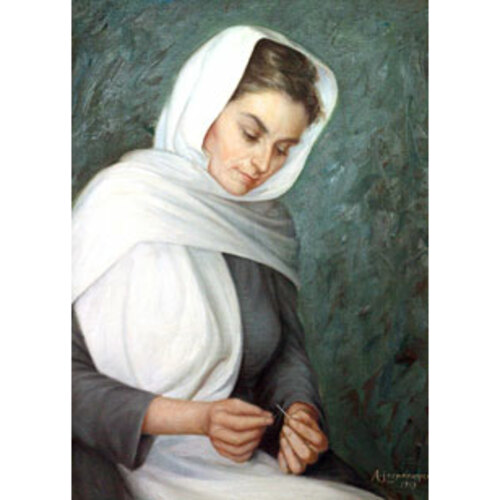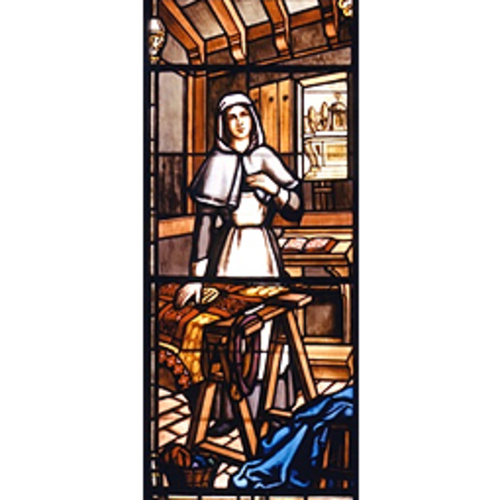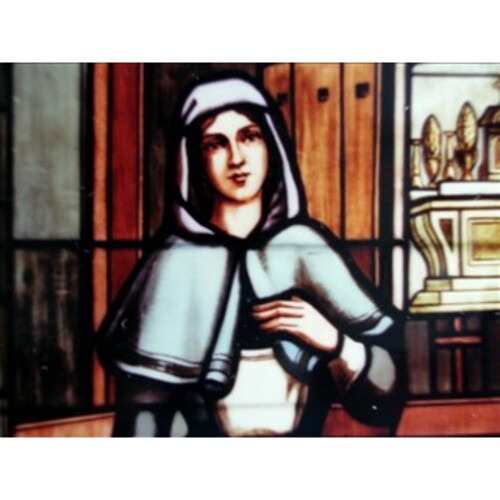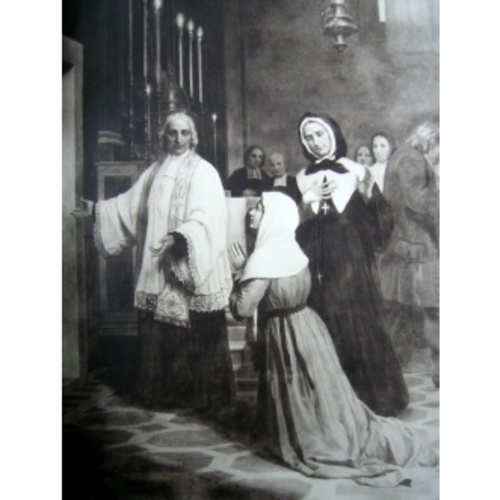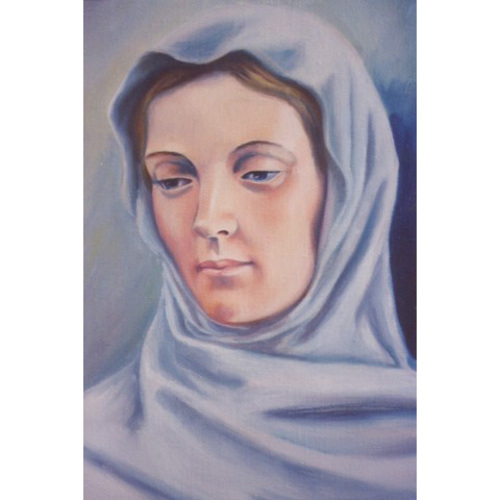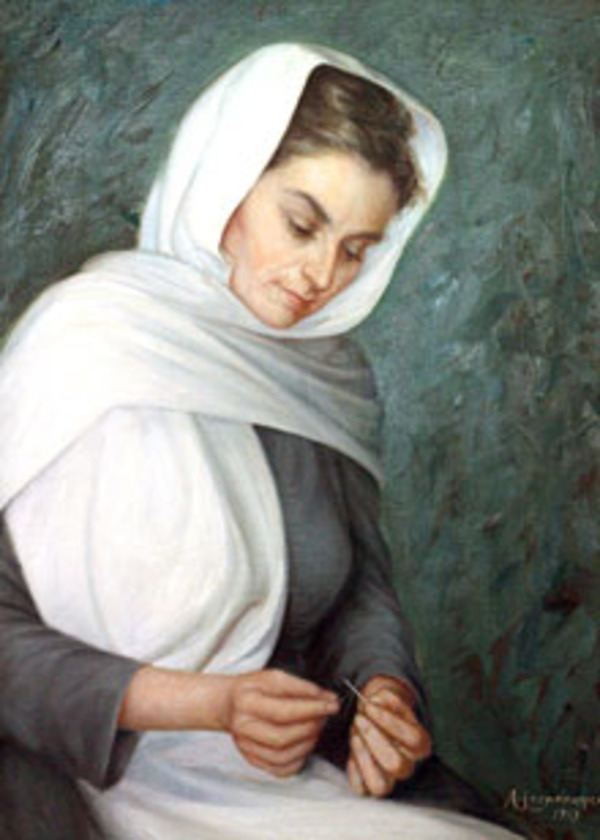
Source: Link
LE BER, JEANNE, famed recluse; b. 4 Jan., 1662 at Montreal, daughter of Jacques Le Ber and Jeanne Le Moyne; d. 3 Oct. 1714 at Montreal.
Jeanne Le Ber was baptized the day she was born by Abbé Gabriel Souart*, Maisonneuve [Chomedey*] being her godfather and Jeanne Mance* her godmother. At an early age she was interested in a religious vocation and frequently visited Jeanne Mance and the Hospitallers. To complete her formal education she spent three years, 1674 to 1677, as a boarder with the Ursulines in Quebec where her aunt, Marie Le Ber de l’Annonciation, taught. The Ursulines were impressed by her many acts of self-denial and were disappointed when, at the age of 15, she returned to her family in Montreal. She was a pensive, withdrawn, and introverted young lady, who daily spent much time in prayer and in adoration of the Sacrament. A friendship with Marguerite Bourgeoys* was greatly to influence her future.
Jeanne Le Ber seemed to savour the social status of her family, however, and always enjoyed prominence and praise for her virtues and talents. As the only daughter (she had three younger brothers) of Jacques Le Ber, with a dowry of approximately 50,000 écus, she was rightly considered the most eligible girl in New France.
The death of one of the sisters of the Congrégation de Notre-Dame in 1679 profoundly affected her; she sought the guidance of Abbé Seguenot, Sulpician parish priest at Point-aux-Trembles (Montreal) who was to remain her confessor, and decided to live a secluded life for a five-year period. With her parents’ permission she retired to a cell at the rear of the church of the Hôtel-Dieu, which served as parish church at that time. Her practices of self-mortification increased: she wore an undergarment of haircloth and corn-husk shoes, she refused to communicate with her family or friends, and she reportedly practised self-flagellation. She left her seclusion only to attend daily mass.
Jeanne Le Ber remained undecided about entering a regular order and taking permanent vows; nevertheless, her determination to shun the attractive life her family offered became evident. In November 1682 she refused to leave her cell to attend her dying mother and later refused to assume the management of the household for her widowed father.
Instead, on 24 June 1685 she took a simple vow of perpetual seclusion, chastity, and poverty. Her spiritual directors, the Abbés Dollier de Casson and Seguenot, encouraged her to continue her pious observances. Her poverty and seclusion, however, were somewhat tempered by the fact that, befitting her social rank, she retained throughout her years of withdrawal from the world an attendant, her cousin Anna Barroy, who saw to her physical requirements and accompanied her to mass. Pleading frailty, she did not abstain from meat as did strict observers in the 17th century. When her brother Jean-Vincent was killed by the Iroquois in 1691, her vows did not prevent her viewing his body and assisting with funeral arrangements. At the same time she attended to a number of business matters, for she had not felt obliged by her vows to divest herself of her property. She ceded the farm at Pointe Saint-Charles to the Hôpital Général of the Charon brothers. Her self-imposed rule of silence was subject to amendment by her spiritual director, and she does not seem to have been refused permission to receive visitors whenever she desired. In 1693, for example, she had a long conversation with M. de La Colombière who wished to re-enter Saint-Sulpice.
When she heard that the sisters of the Congrégation planned to build a church on their property she gave them generous financial assistance on condition that they reserve for her a three-room apartment directly behind the altar, so that she could view the blessed sacrament without leaving her quarters. The apartment was built to her specifications, one room at each of three levels: the lower storey, a vestry for confessions and communion, with a door to the sisters’ garden; the second storey, a simple bedchamber; the upper level, a workroom. Dollier de Casson witnessed the agreement drawn up by the notary Basset, whereby the sisters of the Congrégation promised to supply food, clothing, and fuel, to offer daily intercessions, and to wait on her whenever her lady-in-waiting was absent. In return Jeanne Le Ber provided the capital funds for building and decorating the church and an annual income of 75 livres.
On 5 Aug. 1695 she took the solemn vows of a recluse at a ceremony attended by scores of curious colonists. She spent much time in making church vestments and altar cloths and in fine embroidery. Six or seven hours a day were devoted to prayer and meditation, communion was received four times a week; and when the sisters of the Congrégation retired for the night Jeanne Le Ber would spend hours prostrate before the altar of the deserted and silent church. According to her confessor she did not find complete consolation in her self-abnegation and her religious exercises were always burdensome to her.
She introduced the practice of the perpetual adoration of the Blessed Sacrament and made a gift of 300 livres to the sisters of the Congrégation for its observance. Another 8,000 livres provided for perpetual masses. She also presented them with the tabernacle, ciborium, chalice, ostensorium, and a silver lamp for the chapel.
Throughout the colony she enjoyed a great fame and continued to receive distinguished visitors from time to time. In 1698, Bishop Saint-Vallier [La Croix], returning from France, accompanied two English gentlemen, one of them a Protestant minister, on a visit to her. Her father visited her twice a year. His request to be buried in the church of the sisters of the Congrégation to be near his daughter was granted, but Jeanne, to the disappointment of the curious, did not attend his funeral.
When a final illness overtook her in September 1714 she divested herself of her remaining possessions. The sisters of the Congrégation received 18,000 livres, the revenue of which maintained seven boarders, and all her furniture. She died on 3 October and was buried next to her father.
ACND, M1, Écrits autographes de sœur Marguerite Bourgeois. AHDM, Annales. AHDQ, Annales, 1636–1716. Jug. et délib., VI, 671. “Éloges de quelques personnes mortes en odeur de sainteté à Montréal, en Canada, divisés en trois parties,” APQ Rapport, 1929–30, 143f. Norah Story, The Oxford companion to Canadian history and literature (Toronto, 1967), 446. Marie Beaupré, Jeanne LeBer, première recluse du Canada français (1662–1714) (Montréal, 1939). [É.-M. Faillon], The christian heroine of Canada; or, life of Miss Le Ber (Montréal, 1861), a translation of L’héroïne chrétienne du Canada; ou, Vie de Mlle Le Ber (Ville-Marie [Montréal], 1860). C.-H. Barbeau, “Jeanne Le Ber, sainte artisane,” CF, 2e sér., XXVI (février 1939), 514–28.
Cite This Article
C. J. Jaenen, “LE BER, JEANNE,” in Dictionary of Canadian Biography, vol. 2, University of Toronto/Université Laval, 2003–, accessed January 20, 2026, https://www.biographi.ca/en/bio/le_ber_jeanne_2E.html.
The citation above shows the format for footnotes and endnotes according to the Chicago manual of style (16th edition). Information to be used in other citation formats:
| Permalink: | https://www.biographi.ca/en/bio/le_ber_jeanne_2E.html |
| Author of Article: | C. J. Jaenen |
| Title of Article: | LE BER, JEANNE |
| Publication Name: | Dictionary of Canadian Biography, vol. 2 |
| Publisher: | University of Toronto/Université Laval |
| Year of publication: | 1969 |
| Year of revision: | 1982 |
| Access Date: | January 20, 2026 |


